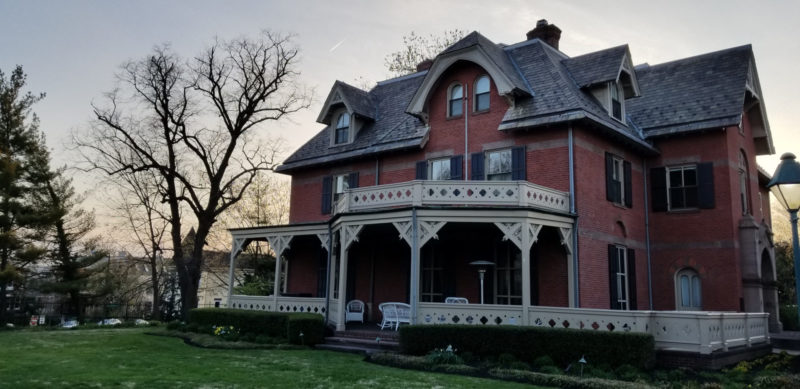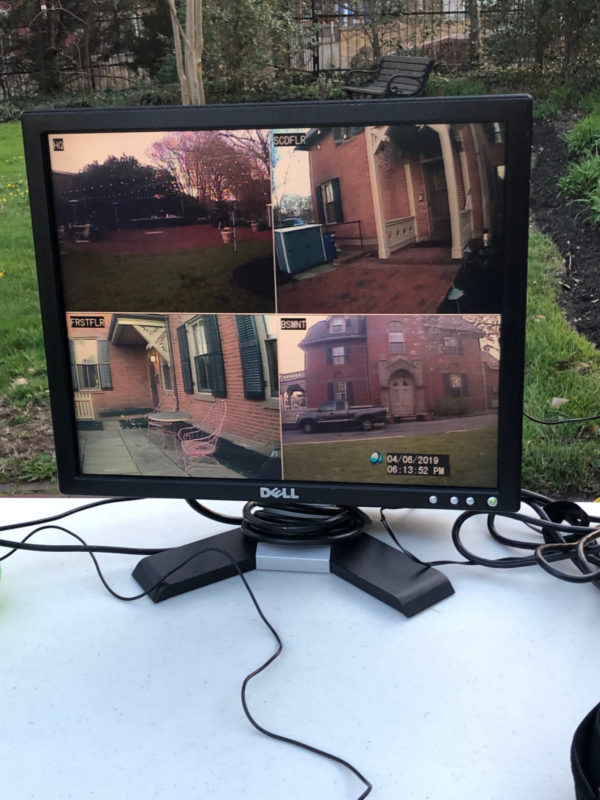Barrier-free access to the ghosts of Gallaudet
26 November 2019 – Sharon Pajka
As the days grow darker and the leaves start to turn, the atmosphere lends itself to spooky stories. Like other colleges, Gallaudet University, the world’s only university designed to be barrier-free for deaf and hard of hearing students, has its share of ghost stories. The university president’s house, for example, has the reputation of being haunted. Built in 1869 for the first president of the university, the 35-room Victorian Gothic Revival mansion (known colloquially as “House One”) is the focus of numerous ghost stories and haunted experiences. Recently, as part of a course I teach on “dark tourism,” my students and I participated in a paranormal investigation of House One that offered opportunities to engage with public history in unconventional ways.

Edward Miner Gallaudet Residence, affectionately known as House One, was built in 1869. Photo credit: Sharon Pajka
Dark tourism is defined as tourism to places that have been historically associated with death and tragedy. A small part of this phenomenon is paranormal tourism, or people taking trips to haunted places and conducting paranormal investigations of a property. I had this in mind when I asked President Roberta J. Cordano for permission to do such an investigation at House One. She has a reputation for being involved (e.g. helping to shovel snow) and accommodating (e.g. housing families in House One during a blizzard)—and even though in Deaf culture there is a strong tradition of storytelling—I was somewhat surprised she agreed.[1] After all, I was requesting after-hours access to one of Gallaudet’s most historic buildings and into the president’s personal space.
Ghosts and haunted buildings are certainly not new to colleges; we love these stories, especially in the fall.[2] Ghost hunting is different; as an academic, I had to question how this activity would both align with the course’s student learning objectives (SLOs) and connect us as a group. In Piled Higher and Deeper: The Folklore of Student Life (1995), folklorist and American Studies scholar Simon J. Bronner explains that ghosts help new students feel attached to a place and even feel at home. Studying ghosts as history, however, is not necessarily common. The other unique aspect of this project was that my students are deaf and use American Sign Language (ASL); none of them have had barrier-free access to haunted tours or paranormal investigations at historic sites, meaning that this class project would expand their access to this folklore.
Gallaudet prides itself on the absence of communication barriers and having direct communication with faculty so that our students can participate fully and directly in class and extracurricular activities. Therefore, it was important to find an all-deaf paranormal investigation team. I could not do so, but Steve Dills, the director of Transcend Paranormal in Richmond, Virginia, explained that they could work with us regardless. Steve assured me that they would use equipment so that no one felt disconnected from the experience and would work with the students on how to proceed. Two students took the lead in developing a research proposal; they collaborated with Transcend Paranormal via email since the investigation team members were non-ASL-users and hearing. Working together, they established communication guidelines for the investigation. Students researched paranormal investigations of historic places and the associated ethical issues of hosting such an event. One aspect that we discussed was the mission of House One as a historic site and what policies should be in place to protect and preserve the site and its collections.
On the evening of Saturday, April 6, 2019, the students gathered in House One’s dining room. President Cordano shared the history of the house, the ghost stories that were passed down to her, and the discussions she had when she met with past university presidents. She discussed the legacy of House One, which was designed for family living and as a center for social life for the Gallaudet community. Accordingly, House One plays a central role in Deaf American history.
Throughout the semester, the students and I had built a strong learning community that enabled everyone to feel comfortable asking questions and clarifying information. They were a strong group of leaders whose sense of belonging was not altered when the paranormal investigation team was present. This was their campus, their investigation, and President Cordano had reminded us that they were stewards of House One. At times, the responsibility of caring for such a significant place of history through investigating and recording its folklore felt daunting, but it also reaffirmed our love for the university and its place in American history.
The evening was filled with cross-language communicating as the paranormal investigator team handed over their priciest technology to students and treated them as peers. ASL interpreters were present, but Transcend Paranormal members showed students what to do instead of telling them. This facilitated direct face-to-face interaction.
For many of us, the most historic part of the evening was President Cordano’s inviting us into her personal living quarters. When we entered, the students, investigators, and I sat on the floor. The lights were turned off during much of the investigation, which paranormal investigators believe may help ghosts communicate but certainly poses challenges when using ASL. This was the one time we used our phones for the flashlight feature. The investigators asked the spirit world questions without receiving a response. When students asked questions only in ASL, without interpreters’ voicing for the investigation team, a flashlight illuminated. Some students jumped while others presumed it to be coincidental until a student signed, “Please turn off the lights,” and the flashlight immediately went out.

The surveillance monitor showing various locations around the President’s House. Photo credit: Sharon Pajka
Regardless of what one believes about the paranormal, this response is significant to us as community members. Sign Language is how our university became what it is. The history of the university includes Thomas Hopkins Gallaudet’s chance encounter with a deaf neighbor who could not communicate. This led him on a journey abroad where he had hoped to learn an oral method to teach the deaf. The oral method of educating deaf children uses only spoken language, lip reading, and voice training. When that did not come to fruition, Gallaudet met French educators who were sharing their success with a manual communication method. On Gallaudet’s return home, he invited one of those educators, Laurent Clerc, to join him. As the story goes, on the return voyage to the United States, Clerc taught Gallaudet sign language and Gallaudet taught Clerc English.[3] Folklorist Elizabeth Tucker argues that “students actively seek confrontations with the supernatural while completing other parts of their education.”[4] Here at Gallaudet, my students’ experience with the supernatural emphasized the university’s bilingual mission and our course SLOs. ASL is a part of our mission and identity and is part of the foundation for lifelong learning and literacy.
After the House One investigation, my students and I held a debriefing about the event. We discussed specific scenarios that influenced the night. I learned that the paranormal investigation had piqued the interest of several students. They had gone to the university archives to research House One and the families who had lived there, and they shared their findings with other students. Does a paranormal investigation have the ability to convey history? Can such an event lead to student engagement with history? It depends. But, barrier-free communication access and historical contextualization make all the difference in the experience.
~Sharon Pajka, Ph.D., is a professor in the English Department at Gallaudet University where she teaches courses in adolescent literature and literary studies. In 2018, she completed a graduate program in public history and began teaching courses on cemeteries, dark tourism, and ghostlore.
[1] Gilbert Eastman (1934-2006), professor emeritus at Gallaudet University and one of the founding members of National Theatre of the Deaf, recounted his experiences of being exposed to ASL storytelling, including ghost stories, while attending the American School for the Deaf. Ben Bahan, “Face-to-Face Tradition in the American Deaf Community: Dynamics of the Teller, the Tale, and the Audience,” in L. H-Dirksen Bauman, Jennifer L. Nelson, and Heidi M. Rose (editors), Signing the Body Poetic: Essays on American Sign Language Literature (Berkeley: University of California Press, 2006): 21-50. Greg Jenkins’s Florida’s Ghostly Legends and Haunted Folklore: North Florida and St. Augustine (Sarasota, FL: Pineapple Press, 2005) devotes an entire chapter (chapter 20) to the ghosts of the Florida School for the Deaf and Blind. Paddy Ladd’s Understanding Deaf Culture: in Search of Deafhood (Clevedon: Multilingual Matters, 2009) discusses how storytelling—and a variety of genres including ghost stories—were important for deaf children at residential schools for the deaf (307).
[2] See Simon J. Bronner, Piled Higher and Deeper: The Folklore of Student Life (Little Rock: August House Publishers, 1995).
[3] “Gallaudet History,” Gallaudet History—Gallaudet University, accessed October 30, 2019, https://www.gallaudet.edu/about/history-and-traditions/150th-anniversary/gallaudet-history.
[4] Elizabeth Tucker, Haunted Halls: Ghostlore of American College Campuses (Jackson: University of Mississippi, 2007), 6.




Interesting, Im paranormal investigation as well and yes I have done many different way to communicate and I have encountered residual and the shadows (different categories).
Id love share my stories with my experience.
Thank you
Stacy Wosika
If ghost is true? Why all suspect in corruption was being jailed and execute?
Ghost is a creation of Human brain… That turn human body into Pony Comedian . comedian in a real ghost sight’s… And that’s what we called natures.
Footnote correction: H-Dirksen L. Bauman.